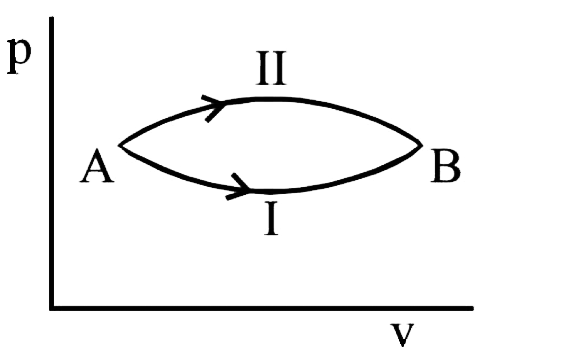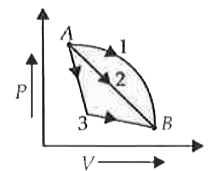A system goes from state A to state B in two different processes I and II (fig.). What is the relation between the respective changes ΔUIandΔUII of internal energy?

The initial and the final states are the same for both the processes. Internal energy is a function of state. The value of ΔU is not path dependent.
So,ΔUI=UB−UAandΔUII=UB−UA
∴ΔUI=ΔUII.
Topper's Solved these Questions
- FIRST AND SECOND LAW OF THERMODYNAMICSBOOK - CHHAYA PUBLICATIONCHAPTER - FIRST AND SECOND LAW OF THERMODYNAMICSEXERCISE - Exercise - Multiple Choice Questions (Mark 1)
31 Videos
- FIRST AND SECOND LAW OF THERMODYNAMICSBOOK - CHHAYA PUBLICATIONCHAPTER - FIRST AND SECOND LAW OF THERMODYNAMICSEXERCISE - Exercise - Very Short Answer Type Questions (Mark 1)
53 Videos
- FIRST AND SECOND LAW OF THERMODYNAMICSBOOK - CHHAYA PUBLICATIONCHAPTER - FIRST AND SECOND LAW OF THERMODYNAMICSEXERCISE - Section Related Questions
50 Videos
- EXPANSION OF SOLIDS AND LIQUIDSBOOK - CHHAYA PUBLICATIONCHAPTER - EXPANSION OF SOLIDS AND LIQUIDSEXERCISE - CBSE SCANNER
2 Videos
- FRICTION BOOK - CHHAYA PUBLICATIONCHAPTER - FRICTION EXERCISE - CBSE SCANNER
7 Videos
Similar Questions
A system goes from state A to B via two processes I and II, as shown in Fig. 12.25, How are δμ1 and δμ2 (the changes in internal energies in the processes I and II) related to each other ?
View SolutionA system goes from A and B via two processes. I and II as shown in figure. If ΔU1andΔU2 are the changes in internal energies in the processes I and II respectively, then

View Solution
Knowledge Check
For an ideal gas the relationship between internal energy change ΔU and enthalpy change ΔH is
AΔU=ΔH+PΔVBΔH=ΔU−ΔPΔVCΔH=ΔU+ΔnRTDΔH=U+PVA system goes from A to B via two processes I and II as shown in the figure. If ΔU1 and ΔU2 are the changes in the internal energies in the processes I and II respectively, then -
 AΔU1=ΔU2Brelation between ΔU1andΔU2 cannot be determinedCΔU2>ΔU1DΔU2<ΔU1
AΔU1=ΔU2Brelation between ΔU1andΔU2 cannot be determinedCΔU2>ΔU1DΔU2<ΔU1An ideal gas goes from state A to state B via three different processes as indicated in the P-V diagram. If Q1,Q2,Q3 indicate the heat absorbed by the gas along the three processes and ΔU1,ΔU2,ΔU3 indicate the change in internal energy along the three processes respectively, then
 AQ1>Q2>Q3 and ΔU1=ΔU2=ΔU3BQ1>Q2>Q3 and ΔU1=ΔU2=ΔU3CQ1=Q2=Q3 and ΔU1>ΔU2>ΔU3DQ3>Q2>Q1 and ΔU1>ΔU2>ΔU3
AQ1>Q2>Q3 and ΔU1=ΔU2=ΔU3BQ1>Q2>Q3 and ΔU1=ΔU2=ΔU3CQ1=Q2=Q3 and ΔU1>ΔU2>ΔU3DQ3>Q2>Q1 and ΔU1>ΔU2>ΔU3
A system goes from A and B via two processes. I and II as shown in figure. If ΔU1andΔU2 are the changes in internal energies in the processes I and II respectively, then

View SolutionA system goes from A and B via two processes. I and II as shown in figure. If ΔU1andΔU2 are the changes in internal energies in the processes I and II respectively, then

View SolutionAn ideal gas is taken from state A to state B via three different processes as shown in the pressure volume(P−V) diagram. If Q1, Q2 &Q3 indicates the heat absorbed by the gas and ΔU1 , ΔU2 &ΔU3 indicate change in internal energy in three processes, then
_PHY_E05_030_Q01.png)
View SolutionA system goes from A and B via two processes. I and II as shown in figure. If ΔU1andΔU2 are the changes in internal enregies in the processes I and II respectively, then

View SolutionAn ideal gas undergoing a change of state from A to B through four different paths I, II,III and IV as shown in the P-V diagram that lead to the same change of state tyhen the change in internal energy is

View Solution
